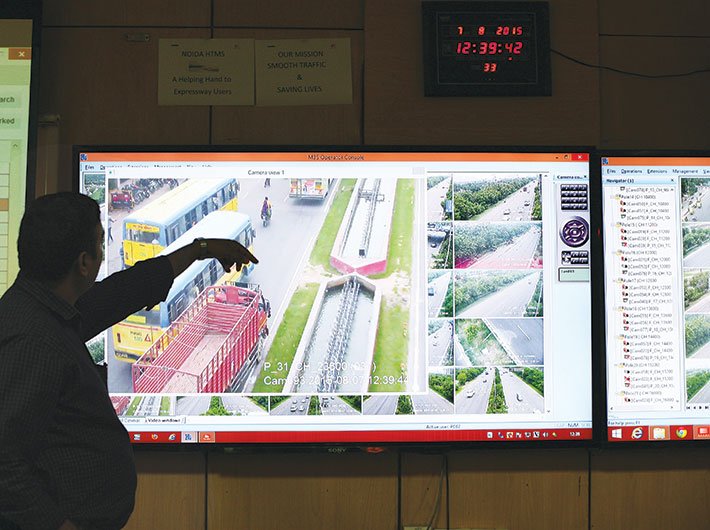ITMS is ensuring enhanced road traffic safety on the Noida-Greater Noida expressway
The 23.6 kms Noida-Greater Noida expressway has been in the limelight for all the wrong reasons. From rowdy biking to road accidents to looting, the expressway has seen it all. But the situation is now improving with the intelligent traffic management system (ITMS) deployed by Noida authority.
ITMS aims to reduce accidents and provide rescue measures. Though the project has been operational since February 2015, the number of accidents came down only after automatic e-challan system was introduced on March 20, 2015. “Till December 2014 the number of accidents on the expressway was 82, which came down to 30-40 percent when e-challan was started. In July 2015 the number came down to 22-23. Instances of criminal loot is zero from past four months,” said Sandeep Chandra, head, Noida traffic cell.
How does ITMS work?
ITMS has 62 fixed box CCTVs and 31 PTZ (pan to zoom) cameras – all laced with infrared for night vision. There is a video incident detection system (VIDS) that captures the irregularities in traffic movement – 15 VIDS cover the expressway. The high-definition cameras for the project were procured from the Polish company Polixel and Traficon of Belgium.
“It works on motion-based algorithm, if regular traffic flow is on the left hand side then in case of any opposite movement the system send alerts to the command room and e-challan is generated,” informed Rajeev Narain Mishra, SP traffic and protocol, Gautam Budha Nagar.
The system also sends automatic alerts when more than two people are seen together or if someone drops any object on the road.
To improve the emergency response there are 24 ECBs (emergency call boxes) on a stretch of every kilometer – 12 on the left hand side and 12 on the right hand side. In case of an accident or crime one can just press the button and talk to the command centre for rescue.
The total stretch of the Noida-Greater Noida expressway and Yamuna expressway is approx 190 kilometers which makes it an easy escape route for criminals fleeing from Delhi. An ANPR (automatic number plate reading) system, which enables hotlisting, keeps a track on such criminals. Once the local police get an alert of a criminal’s escape, the command room can feed the vehicle number in the system. This enables the Noida police to track the car with a particular registration number as soon as it enters the expressway. The system also automatically send an alert to the concerned police officers.
ANPR also detects over-speeding and generates automatic e-challan. Vehicles crossing the speed limit of 100 km/h are detected and an automatic e-challan, along with two photographs of the vehicle with the location, date, time, and speed, is generated. The system is connected to a centralised database VAHAN, from where the details of the owner of the car can be fetched.
The city traffic police, the the signing authority for such challans, uses these "proofs" to issue challans which are sent to the vehicle owner through speedpost. According to Mishra, the realisation from such challans is nearly 85 percent. “The project was started on March 20, 2015. Till July 31, 2015 we generated 9,400 challans and a fine of Rs9 lakh has been collected,” Mishra said. He further informed that the agency has also installed 13 variable message sign boards (VMS) which display cautionary messages and mandatory messages on the expressway.
Nearly 60-kilometer optical fiber network links the ITMS with the control centre. This is where the video feeds are integrated and disseminated. And while the command centre is currently under the Noida authority, it is managed by EFKON India, the company which has implemented the project.
Noida is also coming up with a smart surveillance system to curb crime in the city. “RFPs are going on and will be awarded by August 2015. The project is expected to be operational in a year’s time. A core area will be selected and a pilot will be done. Then it will be replicated in the entire city,” informed Chandra.
pragya@governancenow.com
(The article appears in the August 16-31, 2015 issue)

